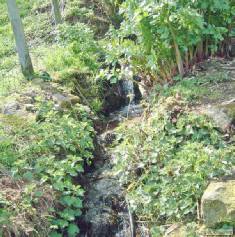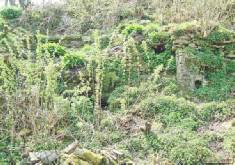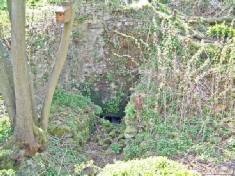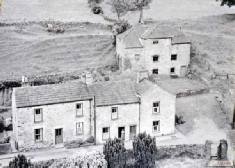


Grinton Corn Mill
Click on a picture to enlarge it and see all the photographs in a slide-show. Note the ‘play’ button in the bottom right corner.
The old corn mill in Grinton in Swaledale may be seen in this old photograph. It is the large stone building set well back from Harkerside Road.
The corn mill was demolished in the early 1950s and the roofing slates and almost all the stone was removed for buildings elsewhere. The hill-side the corn mill stood on is very much steeper that it appears here.
The corn mill site is now the private garden of Mill Cottage.
The lady in the doorway of Mill Cottage was Mr. Mason's mother.
This photograph is copyright of Mr. T. Mason
The nearby Grinton Beck almost dries up in the summer, so the water needed to power the large corn mill water wheel was taken by a leat from Cogden Beck some distance away. Cogden Beck is fed from a spring and drainage from a disused lead mine level and never dries up.
The leat from Cogden Beck runs below Grinton Youth Hostel into a dam, now disused, and thence across the fields where it also provided water for the grazing animals. The water is carried across Grinton Beck at some height by a wooden aqueduct and thence below the vicarage gardens and across the fields above the corn mill.
The mill leat crosses the fields above and many of the stone slabs forming the base, sides and lid on its course are still present.
It enters the mill site along the channel shown on the left.
It then plunges down the vertical stone 'chimney' shown on the right. Presumably the steel plate shown somehow controlled the flow.
It then drove a giant water-wheel that was in the wheel pit shown. The pit is very much larger than appears here.
The water may be seen falling in the dark opening in the lower centre of the photograph.
The water leaves the wheel pit in a stone channel underground, passes under Swale Hall Lane (the Harkerside Road) and under the Grinton Church graveyard before it reappears for a few metres as it flows behind Blackburn Hall into the River Swale.
What's left of the old corn mill. The old waterwheel pit is just off to the left in this photograph.
There is a strange arched room in the lower centre of this picture. It is thought that it may have been connected with drying the corn. Finely perforated and carefully crafted bricks have been found that would have allowed the heat from a fire to circulate to dry the corn.
Archaeology Data Service: reference
Very many thanks to the present owners of Mill House & the old corn mill site for information and permission to photograph the remains of the corn mill . Also thanks to Mr. Tim Mason for permission to use the old photograph of the mill.
Any further information or corrections will be most welcome.






| Villages summary |
| Grinton |
| Gunnerside |
| Reeth |
| The Bridge Inn |
| Blackburn Hall |
| Neddy House |
| The Smithy |
| Grinton Workhouse |
| Herbert Norris' Store |
| Ox Hill |
| Grinton Corn Mill |
| Jabz cave |
| Grinton Lodge YHA |
| Grinton Map |
| Recent Photos |
| Old photos |
| Millennium in Grinton |
| Photo links |
| Assorted photos |
| Riverpath from Grinton |
| Grinton Marrick Walk |
| Grinton Views |
| Flooding near Grinton |
| Floods Dec 2015 |
| Skies over Swaledale |
| Reeth in the snow |
| Church Memorials |
| Churchyard Plans |
| Church Photos |
| War Memorials |
| Church history |
| Church links |
| Conservation Project |
| Parish Newsletter |
| Grinton |
| Blackburn Chapel |
| Chancel |
| East Window |
| Nave |
| North Aisle |
| South Aisle |
| Old Photos |
| Church Bells |
| Church Clock |
| Outside |
| In the Snow |
| Church Roof |
| Places - All entries |
| Grinton |
| Reeth |
| Villages |
| Churches and Chapels |
| St. Andrew's Church, Grinton links |
| Tour of St. Andrew's Church |
| St. Andrew's Church Memorials |
| Grinton War Memorials |
| Grinton Church history |
| Gunnerside |
| My Photos |
| Old photos |
| Photo external links |
| Assorted photos |
| Walk along the riverpath from Grinton |
| Grinton Marrick Circular Walk |
| Grinton Views |
| Flooding near Grinton |
| Skies over Swaledale |
| Reeth in the snow |
| Tim Mason archive |
| The Millennium in Grinton |
| Jubilee 2002 including Corpse Way enactment |
| Church Memorials |
| Churchyard Plans |
| Church Photos |
| War Memorials |
| Church history |
| Church links |
| Conservation Project |
| Parish Newsletter |
| Grinton |
| Blackburn Chapel |
| Chancel |
| East Window |
| Nave |
| North Aisle |
| South Aisle |
| Old Photos |
| Church Bells |
| Church Clock |
| Outside |
| In the Snow |
| Church Roof |